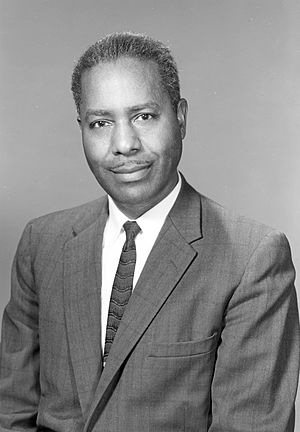Walter McAfee facts for kids
Quick facts for kids
Walter McAfee
|
|
|---|---|

Walter S. McAfee during his time serving as a scientist for the U.S. Army Communication-Electronics Command.
|
|
| Born | September 2, 1914 Ore City, Texas, US
|
| Died | February 18, 1995 (aged 80) |
| Nationality | American |
| Alma mater | Wiley College Ohio State University Cornell University |
| Known for | Project Diana |
| Scientific career | |
| Fields | Astronomy |
| Institutions | Fort Monmouth, New Jersey Monmouth University |
| Doctoral advisor | Hans Bethe |
Walter Samuel McAfee (born September 2, 1914, died February 18, 1995) was an amazing American scientist and astronomer. He is famous for being part of Project Diana. This project made history by bouncing radar signals off the Moon for the very first time!
Contents
Early Life and Family
Walter McAfee was born in Ore City, Texas. His parents, Luther F. McAfee and Suzie A. Johnson, were African-American. When Walter was just three months old, his family moved to Marshall, Texas. He grew up there with his eight brothers and sisters.
He finished high school in Marshall in 1930. Walter often said his high school physics and chemistry teacher, Freeman Prince Hodge, really inspired him. In 1941, Walter married Viola Winston. She was a French teacher at the same junior high school where he taught. They had two daughters together. Walter McAfee passed away at his home in South Belmar, New Jersey, on February 18, 1995.
Walter's Education Journey
Walter McAfee was a very dedicated student. He went to Wiley College, where his mother had also studied. In 1934, he earned his Bachelor of Science degree in mathematics.
After Wiley College, Walter continued his studies at Ohio State University. He earned his Master of Science degree in physics in 1937. Later, after working on a special project called Project Diana, he went back to school. He received a special scholarship called the Rosenwald Fellowship. This allowed him to study for his doctorate at Cornell University. In 1949, Walter earned his PhD in Physics. His important work was about how atomic particles collide, and his advisor was the famous scientist Hans Bethe.
Working for the Army
In May 1942, Walter McAfee left his teaching job in Ohio. He was hired by the Army Signal Corps to work at Fort Monmouth, New Jersey. This was a very important place for electronics research.
Project Diana: Reaching the Moon
At Fort Monmouth, Walter played a key role in Project Diana. He did the first calculations that showed radar signals could be sent from Earth, bounce off the Moon, and then return to Earth. This was a huge scientific achievement! His predictions were proven true in 1946 when the experiment successfully worked. This was the first time humans had ever bounced a signal off another celestial body.
Teaching and Community Work
Besides his work with the Army, Walter McAfee also loved to teach. From 1958 to 1975, he taught physics and electronics at Monmouth College. This school is now known as Monmouth University. He also helped his local community by serving as a trustee at Brookdale Community College.
Awards and Recognition
Walter McAfee received many honors for his amazing contributions to science.
- In 1961, he received the very first U.S. Army Research and Development Achievement Award.
- He was promoted to GS-16, which was the highest civilian rank an African-American person had achieved at that time.
- After he passed away, a research building at Aberdeen Proving Ground was named in his honor in 2011.
- In 2015, he was inducted into the Army Material Command's Hall of Fame.
Walter Samuel McAfee was a true pioneer whose work helped us understand more about space and technology.

